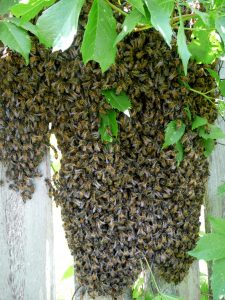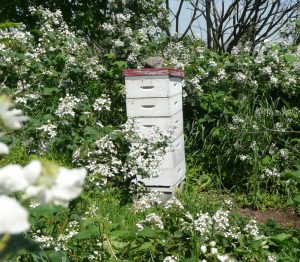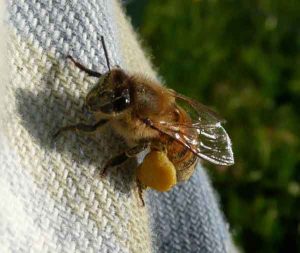Live from the Hive: July 2013
“Swarming Season” By Annie Watson
 There is nothing so thrilling as lying in the grass on a hot May or June day while thousands of bees fly in a circular pattern overhead, the air filled with the sound of their wings. Drawn by the queen’s pheromone, the swarm comes to temporary rest in a large clump on the branch of a tree or other structure. Here they hang in an amazingly quiet cluster until scout bees have found a suitable permanent home. As the sun beats down and the soft grass tickles your arms, you experience Life and Nature in all their glory.
There is nothing so thrilling as lying in the grass on a hot May or June day while thousands of bees fly in a circular pattern overhead, the air filled with the sound of their wings. Drawn by the queen’s pheromone, the swarm comes to temporary rest in a large clump on the branch of a tree or other structure. Here they hang in an amazingly quiet cluster until scout bees have found a suitable permanent home. As the sun beats down and the soft grass tickles your arms, you experience Life and Nature in all their glory.
There’s nothing to fear here. Contrary to popular misconception, a honey bee swarm is not particularly dangerous. Swarming is the natural way for a honey bee colony to reproduce, and the bees are at their most gentle when swarming. If you see a honey bee swarm, DO NOT spray it with water or pesticide! Call a beekeeper (find your local beekeeping organization on the Web) to come and remove it. In the meantime, enjoy watching the swarm from a distance.
For more information about honey bee swarms, go to these sites:
http://entomology.unl.edu/beekpg/beeswarm.shtml
http://whereyouareplanted.com/what-to-do-if-you-see-a-swarm-of-bees-this-spring/
 Now is the time, when the white flowers make them easy to spot, to locate your wild blackberry patches at the edges of fields and in the meadow. Note where they are so you can come back and pick the fruit in July. Look for the first ripe berries about a month after flowering — and thank the bees and other pollinators, because without them, there would be no summer fruit, purple, sweet, and juicy on a hot summer day.
Now is the time, when the white flowers make them easy to spot, to locate your wild blackberry patches at the edges of fields and in the meadow. Note where they are so you can come back and pick the fruit in July. Look for the first ripe berries about a month after flowering — and thank the bees and other pollinators, because without them, there would be no summer fruit, purple, sweet, and juicy on a hot summer day. For the past two days the bees have been coming in absolutely loaded down with bright yellow willow pollen and grey red maple pollen. I wonder how they can even get airborne, the pollen baskets on their back legs are so encumbered with huge blobs of the stuff. It’s funny to watch them as they arrive on the landing board and waddle into the entrance with their booty.
For the past two days the bees have been coming in absolutely loaded down with bright yellow willow pollen and grey red maple pollen. I wonder how they can even get airborne, the pollen baskets on their back legs are so encumbered with huge blobs of the stuff. It’s funny to watch them as they arrive on the landing board and waddle into the entrance with their booty.